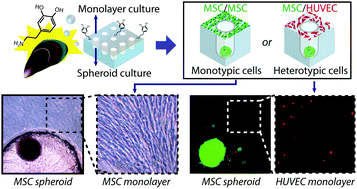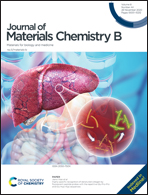Monolayer/spheroid co-culture of cells on a PDMS well plate mediated by selective polydopamine coating†
Abstract
Here, we have selectively coated polydopamine (PDA) onto a polydimethylsiloxane (PDMS) well plate to enable the cell co-culture of a monolayer and spheroids in a semi-segregated manner. During the coating process, the contact between the PDA solution and PDMS well plate was limited to the outer flat surface because the strong hydrophobicity of PDMS prevented the access of the PDA solution into the concave structures. This resulted in a spatially-defined coating of PDA. The success of PDA coating was evidenced by measuring the water contact angle, observing the liquid–air interface, and via PDA-specific metallization. This platform provides a simultaneous cell culture in both a monolayer and spheroids employing either monotypic or heterotypic cells. For the monotypic culture, mesenchymal stem cells (MSCs) were seeded over the well plate to concurrently generate the monolayer and spheroids. In the heterotypic culture, MSCs were first seeded into the wells to form spheroids. Then, human umbilical vein endothelial cells (HUVECs) were added over the flat surface of the well plate and allowed to form a monolayer. The microscopic observation and fluorescence-based cell staining confirmed the clear segregation between the monolayer and spheroids in both monotypic and heterotypic cultures. This new model could pave the way for the construction of a platform closely mimicking the physiological environment used to investigate cell–cell interactions and communications applicable for drug screening.



 Please wait while we load your content...
Please wait while we load your content...